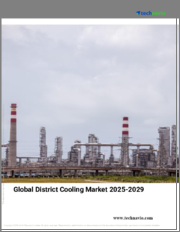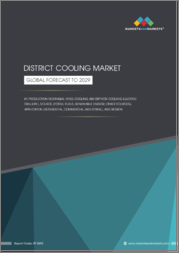
|
시장보고서
상품코드
1683706
세계의 지역 냉방 시장 조사 보고서 : 산업 분석, 규모, 점유율, 성장, 동향, 예측(2025-2033년)Global District Cooling Market Research Report- Industry Analysis, Size, Share, Growth, Trends and Forecast 2025 to 2033 |
||||||
지역 냉방 세계 시장 규모는 2024년 351억 4,000만 달러에서 2033년 840억 2,000만 달러로 2026-2033년 예측 기간 동안 10.17%의 견고한 연평균 성장률(CAGR)을 보일 것으로 예상됩니다.
지역 냉방 시장은 도시화와 에너지 효율적인 냉방 솔루션에 대한 수요 증가에 따라 크게 성장하고 있습니다. 지역 냉방 시스템은 단열 파이프 네트워크를 통해 여러 건물에 중앙집중식 냉방 서비스를 제공하며, 기존 공조 시스템을 대체할 수 있는 지속가능한 대안을 제시합니다. 도시들이 이산화탄소 배출량을 줄이고 에너지 효율을 개선하기 위해 노력하면서 지역 냉방 솔루션의 채택이 확산되고 있습니다. 이러한 추세는 신뢰할 수 있고 효율적인 냉방이 가장 필요한 인구 밀집도가 높은 도시 지역에서 특히 두드러지게 나타나고 있습니다.
또한, 지속가능성과 기후변화에 대한 내성이 강조되면서 지역 냉방 환경도 변화하고 있습니다. 정부와 조직이 녹색 건물과 에너지 효율적인 인프라를 우선시하는 가운데, 지역 냉방 시스템은 에너지 소비와 온실 가스 배출을 줄일 수 있는 능력을 인정받고 있습니다. 이해관계자들이 환경적 목표에 부합하는 솔루션을 추구함에 따라, 지속가능한 관행으로의 전환은 지역 냉방 시장의 성장을 촉진할 것으로 예상됩니다.
또한, 기술의 발전이 지역 냉방 시장에 혁명을 가져올 것으로 예상됩니다. 스마트 그리드 통합, 첨단 제어 시스템, 재생에너지원과 같은 기술 혁신으로 지역 냉방 시스템의 효율성과 신뢰성이 향상되고 있습니다. 이러한 기술 개발을 통해 사업자는 냉각 성능을 최적화하고, 운영 비용을 절감하며, 전체 시스템의 복원력을 향상시킬 수 있습니다. 산업계가 이러한 기술 혁신을 수용함으로써 세계 지역 냉방 시장은 경쟁력과 적응력을 높이고 빠르게 변화하는 에너지 환경 속에서 적절성을 확보할 수 있을 것으로 보입니다.
당사의 보고서는 고객에게 다양한 산업 및 시장에 대한 포괄적이고 실용적인 인사이트를 제공하기 위해 세심하게 작성되었습니다. 각 보고서는 시장 상황을 완전히 이해하기 위해 몇 가지 중요한 요소를 포함하고 있습니다.
시장 개요 : 정의, 분류, 산업 현황 등 시장에 대한 자세한 소개.
시장 촉진요인 : 시장 성장에 영향을 미치는 주요 촉진요인, 억제요인, 시장 촉진요인 및 과제를 상세히 분석합니다. 이 섹션에서는 기술 발전, 규제 변화, 새로운 트렌드 등의 요인을 검토합니다.
세분화 분석 : 제품 유형, 용도, 최종사용자, 지역 등의 기준에 따라 시장을 명확한 부문으로 분류합니다. 이 분석을 통해 각 부문의 성과와 잠재력을 파악할 수 있습니다.
경쟁 상황 : 시장 점유율, 제품 포트폴리오, 전략적 이니셔티브, 재무실적 등 주요 시장 진입기업에 대한 종합적인 평가. 주요 기업들이 채택하고 있는 경쟁 역학 및 주요 전략에 대한 인사이트이 포함되어 있습니다.
시장 예측 : 과거 데이터와 현재 시장 상황을 바탕으로 일정 기간 동안 시장 규모와 성장 추세를 예측합니다. 여기에는 정량적 분석과 향후 시장 궤적을 나타내는 그래프 표시가 포함됩니다.
지역 분석 : 지역별 시장 성과를 평가하고 주요 시장 및 지역 동향을 파악할 수 있습니다. 지역 시장 역학 및 비즈니스 기회를 이해하는 데 도움이 됩니다.
새로운 트렌드와 기회 : 현재 시장 동향과 새로운 시장 동향, 기술 혁신, 잠재적 투자 대상 부문을 식별합니다. 향후 시장 개척 및 성장 전망에 대한 인사이트를 제공합니다.
목차
제1장 서문
제2장 주요 요약
- 시장 하이라이트
- 세계 시장 현황
제3장 지역 냉방 산업 분석
- 소개 : 시장 역학
- 시장 성장 촉진요인
- 시장 성장 억제요인
- 시장 기회
- 산업 동향
- Porter's Five Forces 분석
- 시장 매력 분석
제4장 밸류체인 분석
- 밸류체인 분석
- 원료 분석
- 원료 리스트
- 원료 제조업체 리스트
- 주요 원료 가격 동향
- 잠재적 바이어 리스트
- 마케팅 채널
- 직접 마케팅
- 간접 마케팅
- 마케팅 채널 발전 동향
제5장 지역 냉방 세계 시장 분석 : 생산 기술별
- 생산 기술별 개요
- 생산 기술별 과거·예측 데이터 분석
- 전기식 냉동기
- 히트 펌프
- 흡수식 냉동기
- 프리 쿨링
- 기타
제6장 지역 냉방 세계 시장 분석 : 사용별
- 사용별 개요
- 사용별 과거·예측 데이터 분석
- 저장
- 생산
- 유통
제7장 지역 냉방 세계 시장 분석 : 용도별
- 용도별 개요
- 용도별 과거·예측 데이터 분석
- 상업용
- 주거용
- 산업용
제8장 지역 냉방 세계 시장 분석 : 지역별
- 지역별 전망
- 소개
- 북미의 매출 분석
- 개요, 실적과 예측
- 북미 : 부문별
- 북미 : 국가별
- 미국
- 캐나다
- 멕시코
- 유럽 매출 분석
- 개요, 실적과 예측
- 유럽 : 부문별
- 유럽 : 국가별
- 영국
- 프랑스
- 독일
- 이탈리아
- 러시아
- 기타 유럽
- 아시아태평양 매출 분석
- 개요, 실적과 예측
- 아시아태평양 : 부문별
- 아시아태평양 : 국가별
- 중국
- 인도
- 일본
- 한국
- 호주
- 동남아시아
- 기타 아시아태평양
- 라틴아메리카 매출 분석
- 개요, 실적과 예측
- 라틴아메리카 : 부문별
- 라틴아메리카 : 국가별
- 브라질
- 아르헨티나
- 페루
- 칠레
- 기타 라틴아메리카
- 중동 및 아프리카 매출 분석
- 개요, 실적과 예측
- 중동 및 아프리카 : 부문별
- 중동 및 아프리카 : 국가별 리스트
- 사우디아라비아
- 아랍에미리트
- 이스라엘
- 남아프리카공화국
- 기타 중동 및 아프리카
제9장 지역 냉방 기업 경쟁 구도
- 지역 냉방 시장 경쟁
- 제휴·협력·계약
- 인수합병
- 신제품 발표
- 기타 개발
제10장 기업 개요
- 상위 기업의 시장 점유율 분석
- 시장 집중도
- Emicool
- Engie
- Tabreed
- Vattenfall
- Siemens
- Veolia
- Helen Ltd
- Ramboll Group A/S
- Fortum
- Emirates Central Cooling Systems Corporation PJSC
- Keppel Ltd
- SP Group
- Stellar Energy International
- SHINRYO CORPORATION
- Cetetherm
Global District Cooling Market size is anticipated to grow from USD 35.14 Billion in 2024 to USD 84.02 Billion by 2033, showcasing a robust Compound Annual Growth Rate (CAGR) of 10.17% during the forecast period of 2026 to 2033.
The district cooling market is experiencing significant growth as urbanization and the demand for energy-efficient cooling solutions increase. District cooling systems provide centralized cooling services to multiple buildings through a network of insulated pipes, offering a sustainable alternative to traditional air conditioning systems. As cities strive to reduce their carbon footprints and enhance energy efficiency, the adoption of district cooling solutions is becoming more prevalent. This trend is particularly evident in densely populated urban areas, where the need for reliable and efficient cooling is paramount.
Moreover, the growing emphasis on sustainability and climate resilience is reshaping the district cooling landscape. As governments and organizations prioritize green building initiatives and energy-efficient infrastructure, district cooling systems are being recognized for their ability to reduce energy consumption and greenhouse gas emissions. This shift towards sustainable practices is expected to drive growth in the district cooling market, as stakeholders seek solutions that align with their environmental goals.
In addition, advancements in technology are set to revolutionize the district cooling market. Innovations such as smart grid integration, advanced control systems, and renewable energy sources are enhancing the efficiency and reliability of district cooling systems. These technological developments enable operators to optimize cooling performance, reduce operational costs, and improve overall system resilience. As the industry embraces these innovations, the global district cooling market is likely to see increased competitiveness and adaptability, ensuring its relevance in a rapidly evolving energy landscape.
Our reports are meticulously crafted to provide clients with comprehensive and actionable insights into various industries and markets. Each report encompasses several critical components to ensure a thorough understanding of the market landscape:
Market Overview: A detailed introduction to the market, including definitions, classifications, and an overview of the industry's current state.
Market Dynamics: In-depth analysis of key drivers, restraints, opportunities, and challenges influencing market growth. This section examines factors such as technological advancements, regulatory changes, and emerging trends.
Segmentation Analysis: Breakdown of the market into distinct segments based on criteria like product type, application, end-user, and geography. This analysis highlights the performance and potential of each segment.
Competitive Landscape: Comprehensive assessment of major market players, including their market share, product portfolio, strategic initiatives, and financial performance. This section provides insights into the competitive dynamics and key strategies adopted by leading companies.
Market Forecast: Projections of market size and growth trends over a specified period, based on historical data and current market conditions. This includes quantitative analyses and graphical representations to illustrate future market trajectories.
Regional Analysis: Evaluation of market performance across different geographical regions, identifying key markets and regional trends. This helps in understanding regional market dynamics and opportunities.
Emerging Trends and Opportunities: Identification of current and emerging market trends, technological innovations, and potential areas for investment. This section offers insights into future market developments and growth prospects.
SEGMENTATION COVERED IN THE REPORT
By Production Technique
- Electric Chillers
- Heat Pumps
- Absorption Chillers
- Free Cooling
- Others
By Usage
- Storage
- Production
- Distribution
By Application
- Commercial
- Residential
- Industrial
- COMPANIES PROFILED
- Emicool
- Engie
- Tabreed
- Vattenfall
- Siemens
- Veolia
- Helen Ltd
- Ramboll Group A/S
- Fortum
- Emirates Central Cooling Systems Corporation PJSC
- Keppel Ltd
- SP Group
- Stellar Energy International
- SHINRYO CORPORATION
- Cetetherm
- The above list can be customized.
TABLE OF CONTENTS
1. PREFACE
- 1.1. Report Description
- 1.1.1 Objective
- 1.1.2 Target Audience
- 1.1.3 Unique Selling Proposition (USP) & offerings
- 1.2. Research Scope
- 1.3. Research Methodology
- 1.3.1 Market Research Process
- 1.3.2 Market Research Methodology
2. EXECUTIVE SUMMARY
- 2.1. Highlights of Market
- 2.2. Global Market Snapshot
3. DISTRICT COOLING INDUSTRY ANALYSIS
- 3.1. Introduction - Market Dynamics
- 3.2. Market Drivers
- 3.3. Market Restraints
- 3.4. Opportunities
- 3.5. Industry Trends
- 3.6. Porter's Five Force Analysis
- 3.7. Market Attractiveness Analysis
- 3.7.1 Market Attractiveness Analysis By Production Technique
- 3.7.2 Market Attractiveness Analysis By Usage
- 3.7.3 Market Attractiveness Analysis By Application
- 3.7.4 Market Attractiveness Analysis By Region
4. VALUE CHAIN ANALYSIS
- 4.1. Value Chain Analysis
- 4.2. Raw Material Analysis
- 4.2.1 List of Raw Materials
- 4.2.2 Raw Material Manufactures List
- 4.2.3 Price Trend of Key Raw Materials
- 4.3. List of Potential Buyers
- 4.4. Marketing Channel
- 4.4.1 Direct Marketing
- 4.4.2 Indirect Marketing
- 4.4.3 Marketing Channel Development Trend
5. GLOBAL DISTRICT COOLING MARKET ANALYSIS BY PRODUCTION TECHNIQUE
- 5.1. Overview By Production Technique
- 5.2. Historical and Forecast Data Analysis By Production Technique
- 5.3. Electric Chillers Historic and Forecast Sales By Regions
- 5.4. Heat Pumps Historic and Forecast Sales By Regions
- 5.5. Absorption Chillers Historic and Forecast Sales By Regions
- 5.6. Free Cooling Historic and Forecast Sales By Regions
- 5.7. Others Historic and Forecast Sales By Regions
6. GLOBAL DISTRICT COOLING MARKET ANALYSIS BY USAGE
- 6.1. Overview By Usage
- 6.2. Historical and Forecast Data Analysis By Usage
- 6.3. Storage Historic and Forecast Sales By Regions
- 6.4. Production Historic and Forecast Sales By Regions
- 6.5. Distribution Historic and Forecast Sales By Regions
7. GLOBAL DISTRICT COOLING MARKET ANALYSIS BY APPLICATION
- 7.1. Overview By Application
- 7.2. Historical and Forecast Data Analysis By Application
- 7.3. Commercial Historic and Forecast Sales By Regions
- 7.4. Residential Historic and Forecast Sales By Regions
- 7.5. Industrial Historic and Forecast Sales By Regions
8. GLOBAL DISTRICT COOLING MARKET ANALYSIS BY GEOGRAPHY
- 8.1. Regional Outlook
- 8.2. Introduction
- 8.3. North America Sales Analysis
- 8.3.1 Overview, Historic and Forecast Data Sales Analysis
- 8.3.2 North America By Segment Sales Analysis
- 8.3.3 North America By Country Sales Analysis
- 8.3.4 United States Sales Analysis
- 8.3.5 Canada Sales Analysis
- 8.3.6 Mexico Sales Analysis
- 8.4. Europe Sales Analysis
- 8.4.1 Overview, Historic and Forecast Data Sales Analysis
- 8.4.2 Europe By Segment Sales Analysis
- 8.4.3 Europe By Country Sales Analysis
- 8.4.4 United Kingdom Sales Analysis
- 8.4.5 France Sales Analysis
- 8.4.6 Germany Sales Analysis
- 8.4.7 Italy Sales Analysis
- 8.4.8 Russia Sales Analysis
- 8.4.9 Rest Of Europe Sales Analysis
- 8.5. Asia Pacific Sales Analysis
- 8.5.1 Overview, Historic and Forecast Data Sales Analysis
- 8.5.2 Asia Pacific By Segment Sales Analysis
- 8.5.3 Asia Pacific By Country Sales Analysis
- 8.5.4 China Sales Analysis
- 8.5.5 India Sales Analysis
- 8.5.6 Japan Sales Analysis
- 8.5.7 South Korea Sales Analysis
- 8.5.8 Australia Sales Analysis
- 8.5.9 South East Asia Sales Analysis
- 8.5.10 Rest Of Asia Pacific Sales Analysis
- 8.6. Latin America Sales Analysis
- 8.6.1 Overview, Historic and Forecast Data Sales Analysis
- 8.6.2 Latin America By Segment Sales Analysis
- 8.6.3 Latin America By Country Sales Analysis
- 8.6.4 Brazil Sales Analysis
- 8.6.5 Argentina Sales Analysis
- 8.6.6 Peru Sales Analysis
- 8.6.7 Chile Sales Analysis
- 8.6.8 Rest of Latin America Sales Analysis
- 8.7. Middle East & Africa Sales Analysis
- 8.7.1 Overview, Historic and Forecast Data Sales Analysis
- 8.7.2 Middle East & Africa By Segment Sales Analysis
- 8.7.3 Middle East & Africa By Country Sales Analysis
- 8.7.4 Saudi Arabia Sales Analysis
- 8.7.5 UAE Sales Analysis
- 8.7.6 Israel Sales Analysis
- 8.7.7 South Africa Sales Analysis
- 8.7.8 Rest Of Middle East And Africa Sales Analysis
9. COMPETITIVE LANDSCAPE OF THE DISTRICT COOLING COMPANIES
- 9.1. District Cooling Market Competition
- 9.2. Partnership/Collaboration/Agreement
- 9.3. Merger And Acquisitions
- 9.4. New Product Launch
- 9.5. Other Developments
10. COMPANY PROFILES OF DISTRICT COOLING INDUSTRY
- 10.1. Top Companies Market Share Analysis
- 10.2. Market Concentration Rate
- 10.3. Emicool
- 10.3.1 Company Overview
- 10.3.2 Company Revenue
- 10.3.3 Products
- 10.3.4 Recent Developments
- 10.4. Engie
- 10.4.1 Company Overview
- 10.4.2 Company Revenue
- 10.4.3 Products
- 10.4.4 Recent Developments
- 10.5. Tabreed
- 10.5.1 Company Overview
- 10.5.2 Company Revenue
- 10.5.3 Products
- 10.5.4 Recent Developments
- 10.6. Vattenfall
- 10.6.1 Company Overview
- 10.6.2 Company Revenue
- 10.6.3 Products
- 10.6.4 Recent Developments
- 10.7. Siemens
- 10.7.1 Company Overview
- 10.7.2 Company Revenue
- 10.7.3 Products
- 10.7.4 Recent Developments
- 10.8. Veolia
- 10.8.1 Company Overview
- 10.8.2 Company Revenue
- 10.8.3 Products
- 10.8.4 Recent Developments
- 10.9. Helen Ltd
- 10.9.1 Company Overview
- 10.9.2 Company Revenue
- 10.9.3 Products
- 10.9.4 Recent Developments
- 10.10. Ramboll Group A/S
- 10.10.1 Company Overview
- 10.10.2 Company Revenue
- 10.10.3 Products
- 10.10.4 Recent Developments
- 10.11. Fortum
- 10.11.1 Company Overview
- 10.11.2 Company Revenue
- 10.11.3 Products
- 10.11.4 Recent Developments
- 10.12. Emirates Central Cooling Systems Corporation PJSC
- 10.12.1 Company Overview
- 10.12.2 Company Revenue
- 10.12.3 Products
- 10.12.4 Recent Developments
- 10.13. Keppel Ltd
- 10.13.1 Company Overview
- 10.13.2 Company Revenue
- 10.13.3 Products
- 10.13.4 Recent Developments
- 10.14. SP Group
- 10.14.1 Company Overview
- 10.14.2 Company Revenue
- 10.14.3 Products
- 10.14.4 Recent Developments
- 10.15. Stellar Energy International
- 10.15.1 Company Overview
- 10.15.2 Company Revenue
- 10.15.3 Products
- 10.15.4 Recent Developments
- 10.16. SHINRYO CORPORATION
- 10.16.1 Company Overview
- 10.16.2 Company Revenue
- 10.16.3 Products
- 10.16.4 Recent Developments
- 10.17. Cetetherm
- 10.17.1 Company Overview
- 10.17.2 Company Revenue
- 10.17.3 Products
- 10.17.4 Recent Developments

















